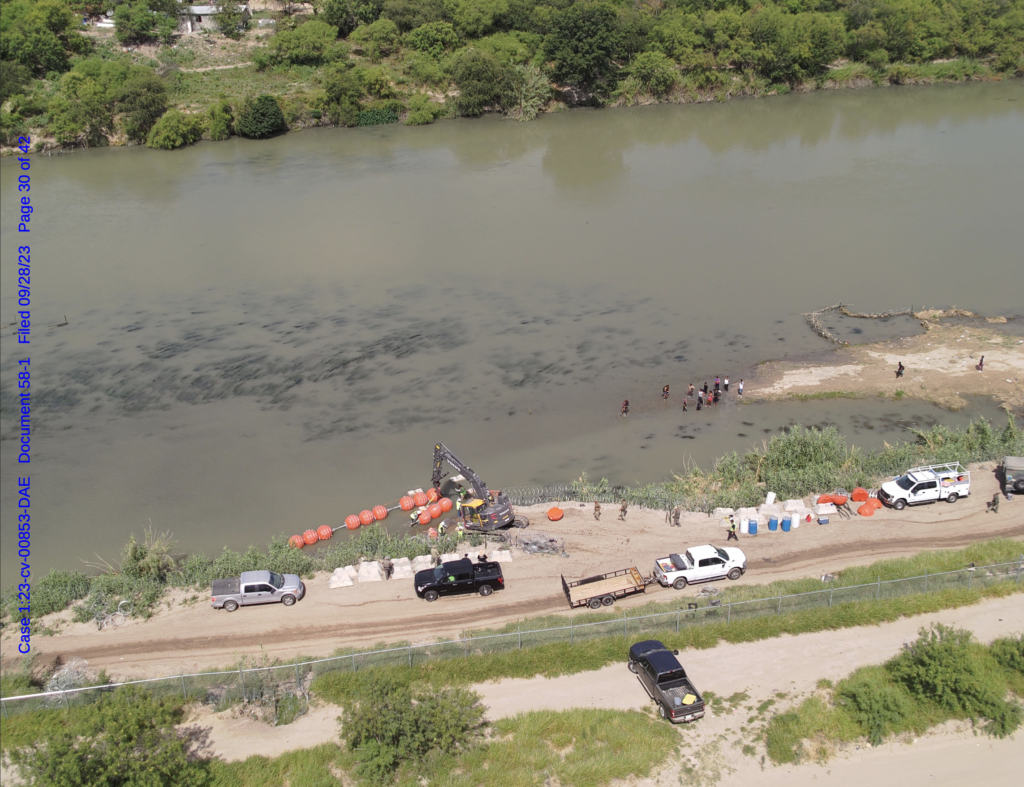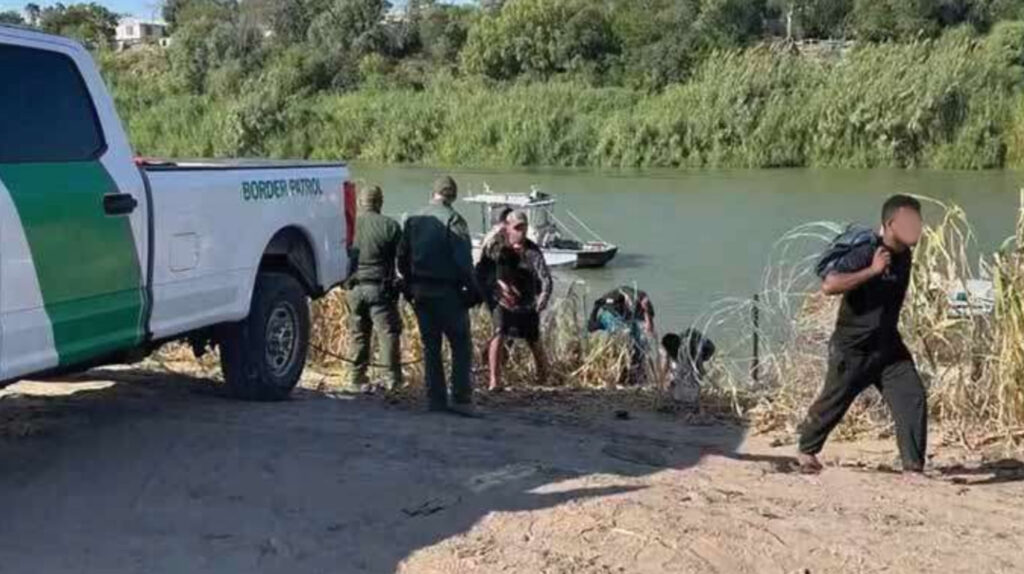
PHOTO COURTESY ABRAHAM GARCIA
Texas Gov. Greg Abbott can leave the 1,000-foot stretch floating buoy barrier in the Rio Grande near Eagle Pass for now until a rehearing of the case before the entire 5th U.S. Circuit Court of Appeals takes place in May.
“A member of the court having requested a poll on the petition for rehearing en banc, and a majority of the circuit judges in regular active service and not disqualified having voted in favor, to hear this case en banc,” states the Jan. 17 order.
The 5th Circuit ordered the case to be reheard after Texas Attorney General Ken Paxton made the request in a petition filed the same day.
Álvaro J. Corral, an assistant professor in the UTRGV Department of Political Science, said rehearing the case would benefit Texas “given the record of the 5th Circuit on these cases.”
“They tend to side often with state authority in granting the state of Texas leeway in terms of its approach to border enforcement at the state level,” Corral said.
The court of appeals requested the United States and Abbott to provide 22 copies of their “previously filed merits briefs, reply briefs, supplemental briefs, and record excerpts” for the use of the en banc, or whole, court.
“[En banc] means that an entire appellate court sits to review a case, as opposed to the common appellate practice of sitting in panels,” according to the Ballotpedia website.
Corral said a decision in favor of Texas would expand the power of the state.
“It’s sort of who reigns supreme at the border. … Based on legal precedent, it is the federal government that is in charge of immigration enforcement at borders,” he said. “However, in the state taking this action with the buoys … the state is testing how far it can go. A decision that would favor Texas would be inching that state power further along against federal power. A decision against the state would, I think, further solidify existing case law in this regard.”
Corral said it is difficult to sustain the safety argument on the floating barrier.
“There’s a stronger, immediate, more direct case to be made that the buoys themselves harm migrants themselves,” he said. “So, you have to understand the context of Gov. Greg Abbott’s contention there. I read his argument there as this measure is necessary to protect the safety of Texas at the exclusion of the safety of migrants. … And so, disentangling whose safety we are referring to is critical here.”
In a letter dated Jan. 14 to Texas Attorney General Ken Paxton, Jonathan E. Meyer, general counsel of the Department of Homeland Security, demanded that Texas “ immediately cease and desist any actions taken by the State that block Border Patrol’s full access to the U.S.-Mexico border in and around the Shelby Park area.”
Shelby Park is located in Eagle Pass.
The Rider obtained the letter that Paxton replied to from the website documentcloud.org.
“Texas’s failure to provide access to the border persists even in instances of imminent danger to life and safety,” Meyer’s letter states. “On January 12, 2024, upon learning from Grupo Beta, a group affiliated with the National Institute of Migration of Mexico, that a group of migrants was attempting to cross the river, Border Patrol contacted Texas officials and requested access to the border. Texas refused. Later, a rescue team from Mexico was able to rescue two individuals from the group, both with signs of hypothermia. Three individuals drowned.”
Paxton replied on Jan. 17, “Your attempt to blame Texas for three migrant deaths on January 12, 2024 is vile and, as you now should be aware, completely inaccurate. ‘Three individuals drowned’ that night on the Mexican side of the Rio Grande, but that tragedy is your fault. Contrary to your letter, [the Texas Military Department] did not prevent U.S. Border Patrol from entering Shelby Park to attempt a water rescue of migrants in distress.”

COURTESY PHOTO
Corral said he believes there are other ways to fulfill Abbott’s goals of safety without harming migrants.
Since its start, Operation Lone Star has resulted in over 496,000 migrant apprehensions, over 38,500 criminal arrests and more than 34,900 felony charges, according to a Jan. 19 news release from the governor’s office.
During the border mission, the Texas Department of Public Safety seized over 453 million lethal doses of fentanyl.
Texas’ construction of the floating barrier violated two of the three courses of conduct by Section 10 of the Rivers and Harbors Act, according to the Sept. 6 order granting the United States’ motion for preliminary injunction in the U.S. v. Abbott case.
The first clause of the Harbors Act prohibits the creation of “any obstruction not affirmatively authorized by Congress, to the navigable capacity of any of the waters of the United States,” according to the order.
The second clause makes it unlawful “to build or commence the building of any wharf, pier, dolphin, boom, weir, breakwater, bulkhead, jetty, or other structures in any port, roadstead, haven, harbor, canal, navigable river, or other water of the United States,” according to the preliminary injunction motion.
Around July 10, Texas began installing the floating barrier, according to the order.
On Jan. 22, in another immigration case (Homeland Security, et al. v. Texas), the U.S. Supreme Court allowed U.S. Border Patrol agents to remove razor wire installed by Texas at the border along a 29-mile stretch of the Rio Grande.
“In response to increased border crossings, Texas has placed rolls of concertina wire (a type of coiled razor wire) in numerous locations, including as relevant here along a 29-mile stretch of the riverbank in Eagle Pass, much of which is private land,” states the Justice Department’s application to vacate the injunction pending Abbott’s appeal filed Nov. 29 before the U.S. Court of Appeals for the 5th Circuit. The request to vacate the injunction was denied.
Corral said the decision the Supreme Court took on the razor wire was surprising.
“Supreme Court Chief Justice John Roberts and Associate Justice Amy Coney Barrett siding with the three liberals to make a 5-to-4 favorable decision in favor of the federal government, I think, is surprising,” he said.
Justices Elena Kagan, Sonia Sotomayor and Ketanji Brown Jackson also sided with the Biden administration, while Justices Clarence Thomas, Samuel Alito, Neil Gorsuch and Brett Kavanaugh voted to keep the injunction in place.
The Supreme Court’s recent ruling on Jan. 22 approved an urgent request by the Biden administration to allow Border Patrol agents to remove the razor wire.
On Oct. 24, 2023, Paxton sued the Biden administration for destroying concertina wire fencing that Texas had deployed “to reduce the record-breaking influx of illegal immigration,” according Paxton’s news release on Jan. 22.
“This is not over,” Abbott wrote on platform X (formerly known as Twitter) on Jan. 22, referring to the razor wire case.
“Texas’ razor wire is an effective deterrent to the illegal crossings Biden encourages,” he wrote. “I will continue to defend Texas’ constitutional authority to secure the border and prevent the Biden Admin from destroying our property.”
In his Jan. 22 news release, Paxton stated the Supreme Court’s temporary order allows Biden to continue his illegal effort to aid the foreign invasion of America.
“The destruction of Texas’s border barriers will not help enforce the law or keep American citizens safe,” he stated in the news release. “This fight is not over, and I look forward to defending our state’s sovereignty.”
Paxton also stated that although the Supreme Court has permitted the destruction of the razor wire, the appeal remains ongoing.
“The Office of the Attorney General will argue the case in front of the Fifth Circuit on February 7,” the release states.

PHOTO COURTESY ABRAHAM GARCIA





